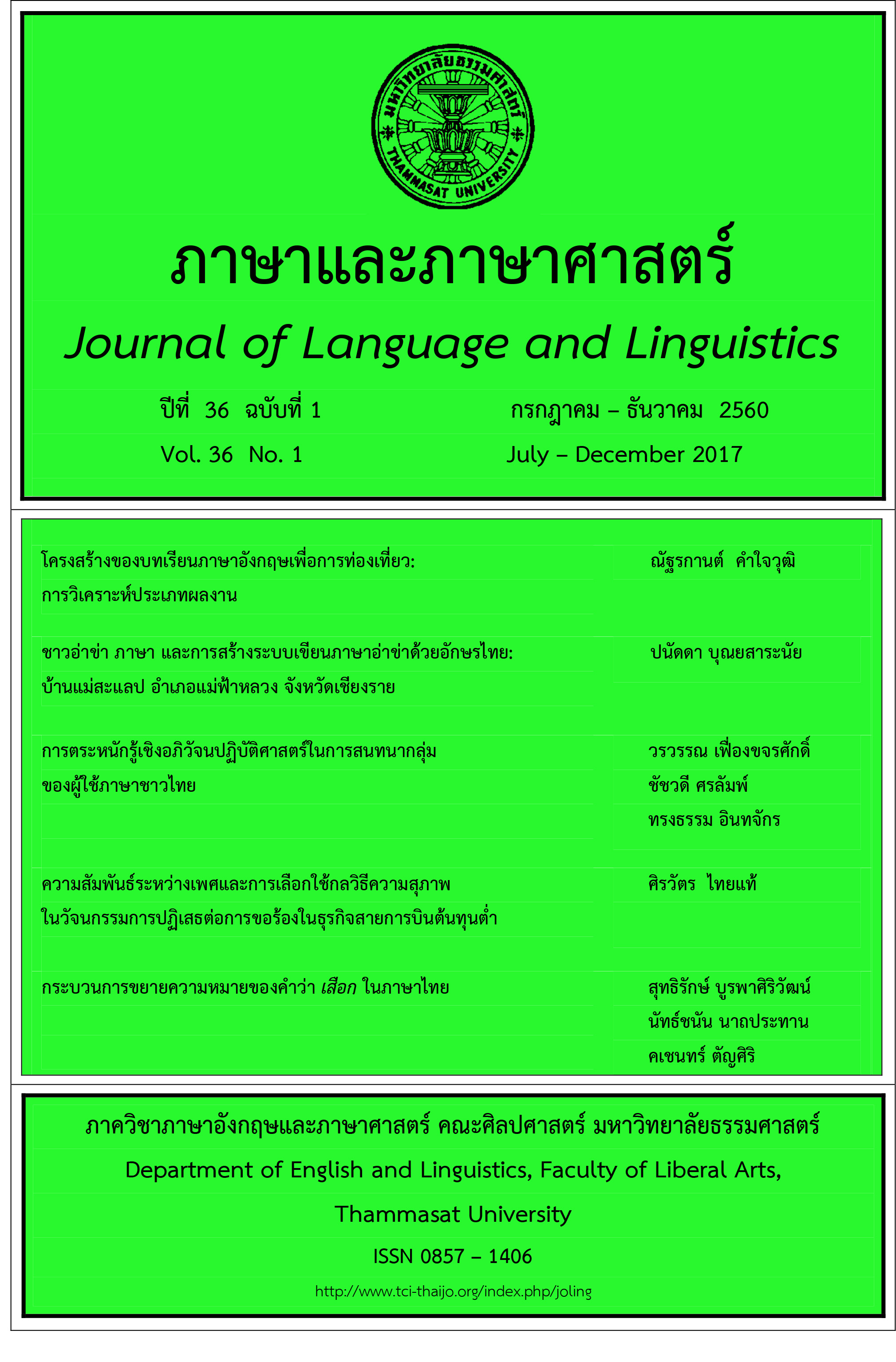Akha people, language and Thai-based orthography: Ban Mae-sa-laep, Mae-fa-luang district, Chiang Rai province
Main Article Content
Abstract
This article describes the background and history of the Akha people, and examines the significant distinctive features between Akha and Thai phonology. It also looks at the implications of linguistic knowledge in creating a Thai-based orthography by Akha native speakers. It further suggests ways of how the Akha can write and record their own wisdom and culture while cooperating with an academic institution. Akha are a highland ethnic group consisting of approximately 2.5 million people scattered throughout the southern part of Xishuangbanna, Yunnan province, China, northeastern Myanmar, the north of Thailand and Laos. Akha language is a language of theSouthern Lolo branch of Tibeto-Burman language family. There are 22initials without final consonant phonemes;  . There are 13 vowels; 9 primary vowels;
. There are 13 vowels; 9 primary vowels;  , 2 secondary vowels; /y,O/, 1 nasalized vowel; /a)/and 1 syllabic; /i,y,e,O,E,a,,o,u,ö,«,a),m`/.There are 6 tonemesof mid, highand low levels which divide into 2 types; oral
, 2 secondary vowels; /y,O/, 1 nasalized vowel; /a)/and 1 syllabic; /i,y,e,O,E,a,,o,u,ö,«,a),m`/.There are 6 tonemesof mid, highand low levels which divide into 2 types; oral  and creaky tones
and creaky tones  . The Akha native speakers of Ban Mae-Sa-Laep, Mae-Fa-Luang district, Chiang Rai province have cooperated with an academic institute to study the Akha phonology. They selected the Thai alphabet to develop a writing system for all the Akha consonants, vowels and tones. This Thai-based writing system was tested by writing Akha words, sentences, folk tales, proverbs etc. and then edited and revised by Akha native speakers.
. The Akha native speakers of Ban Mae-Sa-Laep, Mae-Fa-Luang district, Chiang Rai province have cooperated with an academic institute to study the Akha phonology. They selected the Thai alphabet to develop a writing system for all the Akha consonants, vowels and tones. This Thai-based writing system was tested by writing Akha words, sentences, folk tales, proverbs etc. and then edited and revised by Akha native speakers.
Article Details
บทความทุกบทความเป็นลิขสิทธิ์ของภาษาและภาษาศาสตร์
References
ปนัดดา บุณยสาระนัย. (2547). การฟื้นฟูและสร้างอัตลักษณ์ทางชาติพันธุ์ของชาวอ่าข่าในประเทศไทยและประเทศเพื่อนบ้าน. ใน วาทกรรมอัตลักษณ์. (เอกสารวิชาการลำดับที่ 39) (น.169-198).
กรุงเทพฯ: ศูนย์มานุษยวิทยาสิรินธร (องค์การมหาชน)
ปนัดดา บุณยสาระนัย และหมี่ยุ้ม เชอมือ. (2547). อาข่า หลากหลายชีวิตจากขุนเขาสู่เมือง. เชียงใหม่: สถาบันวิจัยสังคม มหาวิทยาลัยเชียงใหม่.
สุวิไล เปรมศรีรัตน์และคณะ. (2547). แผนที่ภาษาของกลุ่มชาติพันธุ์ต่าง ๆ ในประเทศไทย. กรุงเทพฯ: สำนักงานคณะกรรมการวัฒนธรรมแห่งชาติ.
อาสี เดโชธ ารง และคณะ. (2561). รายงานความก้าวหน้า โครงการ “ฟื้นฟูภาษาและภูมิปัญญาท้องถิ่นผ่านประวัติศาสตร์และคำสอนชาวอาข่า” บ้านแม่สะแลป ต.แม่สะลองใน อ.แม่ฟ้าหลวง
จ.เชียงราย. กรุงเทพฯ: สำนักงานกองทุนสนับสนุนการวิจัย (สกว.) ฝ่ายวิจัยเพื่อท้องถิ่น.
Geusau, Leo Alting Von. (2000). “Akha Internal History: Marginalization and the Ethnic Alliance System” in Civility and Savagery: Social identity in Tai States. Andrew
Turton (editor) London: Curzon Press.
Lewis, Paul W. (1989). Akha-English–Thai Dictionary. Bangkok: Darnsutha Press Co.Ltd.
Lewis, Paul W., Bibo Bai and (1996). Hani-English/English-Hani Dictionary: HaqniqdoqYilyidoq doqlo-soqdaoq. London and New York: Kegan Paul International in association with International Institute for Asian Studies (Leiden, Netherlands).
Panadda Bamrung. (1993). A Phonological Study of Akha in Pa-kha-suk-jai village, Tambol Mae-sa-long-nok, King Amphur Mae-fa-luang, Chiang Rai province. Master
of Arts (Linguistics), Nakhonpathom: Mahidol University.
Panadda Boonyasaranai. (2010). The Development and Use of Common Akha Orthography. Doctor of Philosophy (Linguistics), Nakhonpathom: Mahidol
University.


